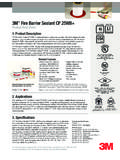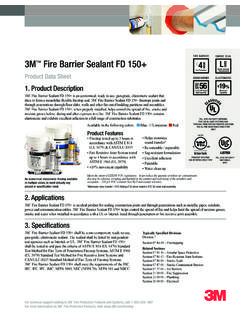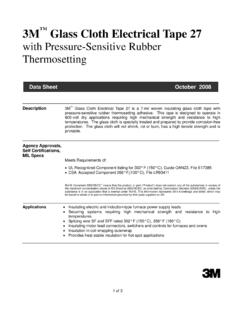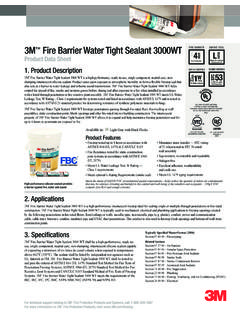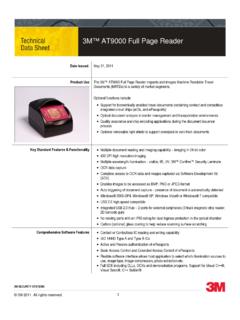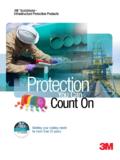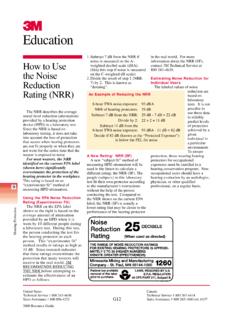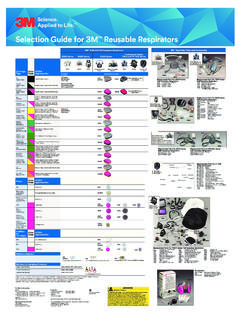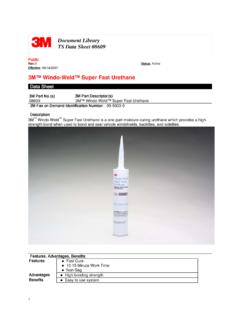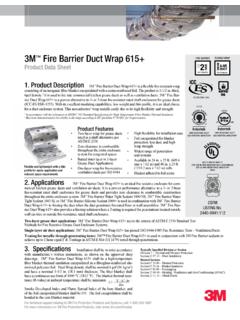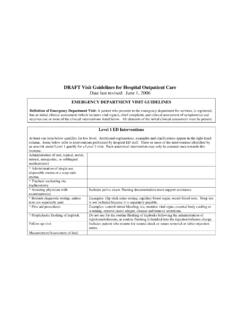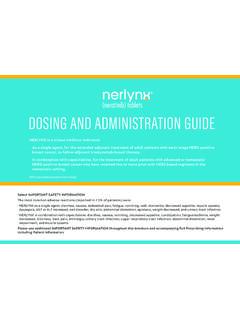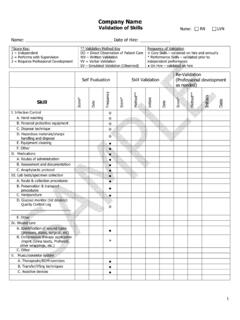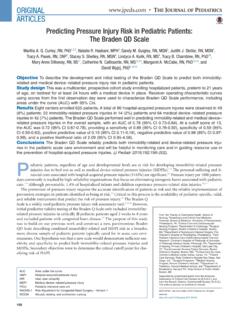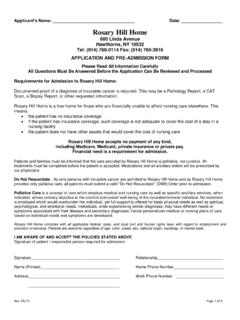Transcription of Understanding and preventing MARSI
1 Understanding and preventing MARSI Medical Adhesive-Related Skin InjuriesJ3256173M, Cavilon, Tegaderm, Micropore, Transpore, Microfoam, Medipore and Durapore are trademarks of 3M Company. 3M learn more about how 3M can help you and your facility prevent and treat MARSI , contact your 3M Critical & Chronic Care Solutions representative or call our Customer Service team on 0845 873 4076 Even with the best care, some patients will experience injury due to medical adhesives. 3M offers a full range of solutions for skin integrity and wound 1 Wysocki AB. Anatomy and Physiology of Skin and Soft Tissue. In: Bryant, RA and Nix DP eds. Acute and Chronic Wounds: Current Management Concepts.
2 4th ed. St Louis, MO: Elsevier Mosby; 2012: 40-622 Roth RR and James WD. Microbial ecology of the Skin. Annu. Rev. Microbiol. 1988; 42: 441 4643 NICE Medical technology guidance Published: 22 July 2015, George M. Role of skin protectant in reducing the local complications in PICC lines. Poster presentation at the 2013 meeting of the infusion Nursing Society5 Link D and Cutler C. In search of a better central line dressing in the autologous bone marrow reinfusion patient. 1998. 3M White Paper6 Campbell K et al. A clinical evaluation of 3M Cavilon No Sting Barrier Film. Ostomy Wound Management. 2000; 46(1):24 307 Grove GL. et al. Comparison of the skin protection properties of various film forming skin protectants.
3 Poster presentation at the Wound, Ostomy, and Continence Nurses Society Annual Conference. 19938 3M Data on file 2013; CLIN-MISC-US-05-2022119 3M Data on file 2012; CLIN-MISC-US-05-20129210 3M Data on file 2009; I2MS 1123011 Rowley S, Clare S (2011) ANTT: a standard approach to aseptic technique. Nursing Times 107(36)12 3M Data on file 2011; CLIN-MISC-US-05-16900813 3M Data on file 2004; I2MS 1002914 3M Data on file 2004; I2MS 1003015 3M Data on file 2004; I2MS 1003116 Skin impairment associated with vascular access devices and semi-permeable transparent dressings, Hitchcock J., et al, Imperial College Healthcare NHS Trust. Poster Presentation, NIVAS, 201517 3M Internal Data.
4 Barrier properties of surgical tapes Durapore and Microfoam. Study 05-010041. 2005 18 Grove, GL et al. Adhesive tape trauma evaluation of two gentle tapes in healthy human subjects. Poster presentation, WOCN, New Orleans. June 2011 19 CUST-CVE-05-146472. Customer Validation Evaluation of 3M Kind Removal Silicone Tape. February 2011 20 3M Internal Data. Investigators Report. LIMS 09698. 200321 3M Internal Data. LIMS07972. 1999 United Kingdom PLC 3M House Morley Street Loughborough Leicestershire LE11 1EP+44 (0)1509 611 611 3M Ireland Limited The Iveagh Building, The Park, Carrickmines, D18 X015 Ireland+353 (0)1 280 3555 Protecting patient comfort and safety3M convened a panel of 23 recognised key opinion leaders to establish consensus statements to serve as guidelines for proper assessment, prevention, product selection and usage, and treatment of skin injuries.
5 * Out of this conference came the term MARSI (Medical Adhesive-Related Skin Injuries). MARSI is a prevalent and serious complication that occurs across all care settings and among all age groups, yet such injuries are generally accepted as an inevitable part of patient care. MARSI is under reported because it is not currently categorised as an adverse event. Therefore the prevalence and financial impact of MARSI is unknown. A study in the in 2008 suggested that the annual cost to hospitals to treat tape-related skin injuries exceeded $11 million.**With increased awareness, education and implementation of these guidelines, you can improve the patient experience, help reduce health care costs and improve is MARSI ?
6 A Medical Adhesive-Related Skin Injury is an occurrence in which erythema and/or other manifestation of cutaneous abnormality (including, but not limited to, vesicle, bulla, erosion, or tear) persists 30 minutes or more after removal of the adhesive. Applicationand removalProduct selectionAssessmentPreventionTreatmentA leader in medical adhesivesAt 3M we collaborate and apply science in powerful ways to improve lives daily. We have a history of developing the right kind of adhesive for almost any medical application, including the category of gentle-to-skin medical tape. 3M Micropore Surgical Tape is trusted by millions of healthcare professionals around the world.
7 Our culture of collaboration, investment in research and development and expertise in adhesive technology has enabled us to develop the tapes, dressings, skin closures and professional skin care products you depend upon to enhance patient care. 3M scientists around the world continue to innovate, creating proven solutions which help prevent and treat critical and chronic conditions across the continuum of *The Consensus Summit was made possible by an unrestricted educational grant from 3M.**Gannon, et al. Clinical Symposium on Advances in Skin & Wound Care. s application of science can help you to prevent MARSI Be aware of, and reduce as far as possible, any potential for harm associated with your practice.
8 The Nursing and Midwifery Council Code, effective from 31 March 2015 Icon indicates information featured in the Consensus Visit to download a copy of the complete Medical Adhesive and Patient Safety: State of the Science Consensus Statements for the Assessment, Prevention, and Treatment of Adhesive-Related Skin 3M Health Academy at for a range of relevant e-learning strippingRemoval of one or more layers of the stratum corneum following removal of medical adhesive; stripped skin may appear shinyTension injury or blisterSeparation of the epidermis from the dermis as a result of distension of skin under an unyielding adhesive; blisters often develop at the edge of the adhesiveFolliculitisInflammatory reaction in hair follicle caused by shaving or entrapment of bacteria; appears as small, inflamed elevations of skin surrounding hair follicleMacerationSoftening and breakdown of the skin resulting from prolonged exposure to moisture; increases susceptibility to damage; skin appears wrinkled and white/grey in colourIrritant contact dermatitisReaction ranging from erythema and scaling to necrotic burns from non-immunologic damage caused by irritant chemicals in contact with the skin.
9 May appear reddened and swollenSkin tearWound caused by shear, friction and/or blunt force resulting in separation of skin layers; can be partial- or full-thicknessAllergic contact dermatitisRarer immunologic response to adhesive or backing; typically appears as an area of erythematous, vesicular, pruritic dermatitis; may persist for up to a week after allergen removedIdentifying MARSIA ssessmentSkin stripping from tape used to secure endotracheal tubesFolliculitisTension injury or blisterSkin stripping from adhesives: central line dressingsMaceration from adhesives: Negative Pressure Wound Therapy (NPWT), tapes, dressings, ostomy pouchesVarious intrinsic and extrinsic factors influence risk of skin injury: age-related physiologic factors, race/ethnicity, underlying medical conditions, malnutrition and dehydration, drying of the skin, prolonged exposure to moisture, certain medications, radiation therapy, photo damage and previous use of adhesive products.
10 As with all aspects of health care, the foundation for preventing and treating MARSI begins with proper patient can occur anywhere adhesives are usedTypes of MARSIC ommon occurrences of MARSI5 Documentation tipWhen assessing your patients , it s important to document the specific type of MARSI that occurs: skin stripping, tension blister, skin tear, irritant contact dermatitis, allergic dermatitis, maceration or folliculitis. Avoid the term tape burn. Protocols for assessing and documenting pressure ulcers and skin tears have led to significant reduction in the incidence and prevalence of these types of skin damage. While most facilities currently do not assess or track the risks of Medical Adhesive-Related Skin Injuries, documentation and tracking tools can be adapted to include criteria for tape adhesive Acrylate adhesive initially adheres to the skin cells closest to the top, leaving some gaps in adherence.
